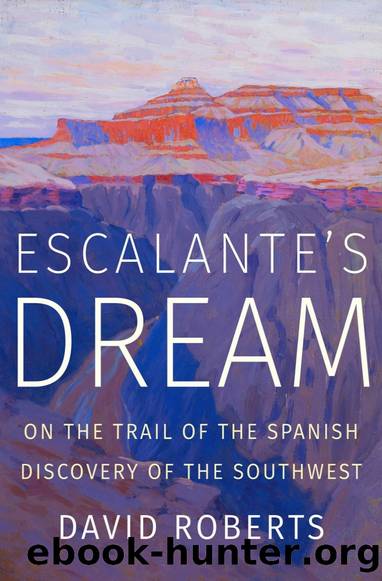Escalante's Dream: On the Trail of the Spanish Discovery of the Southwest by David Roberts

Author:David Roberts [Roberts, David]
Language: eng
Format: epub
ISBN: 9780393652079
Google: eQV1DwAAQBAJ
Amazon: B07JQZJG56
Barnesnoble: B07JQZJG56
Goodreads: 41817547
Published: 2019-04-29T00:00:00+00:00
ESCALANTE DOES NOT say whether the team thought the San Buenaventura was the fabled Tizón. But it was the biggest river they had crossed on the whole journey, bigger even than the Rio Grande, by which yardstick they measured all the waterways they discovered. The men spent two days on the banks of the Green, resting their horses. They managed to kill another bison, a small one, from which âwe enjoyed little meat.â Yet there was a sense within the party that something monumental had been accomplished. On the very edge of the river there were âsix big black poplars [cottonwoods] which had grown in pairs,â as well as another standing alone. On that solitary tree JoaquÃn Lain used his adze to cut a rectangular âwindowâ in the bark, then wielded a chisel to carve âYear of 1776,â his last name, and two Christian crosses. It was a conscious imitation of the inscription Rivera had carved in the big cottonwood on the banks of the Gunnison in 1765, which D & E had searched for in vain.
Herbert E. Bolton, retracing the expedition route in 1950, believed he had found the same grove. âThe six giant cottonwoods still stand at the site described by Escalante,â he wrote in Pageant in the Wilderness, âbut the inscription, perhaps covered by the growth of a century and three-quarters, is not visible.â The historianâs claim was one more example of partisans of D & E needing to be more certain than they had any right to be that they had found traces of the long-ago journey. Later a team of botanists from the University of Utah cored the cottonwoods and found that none of them was more than seventy-five years old.
Celebratory those days on the banks of the Green may have been. Escalante envisioned a future settlement here, complete with irrigation ditches to water the fields. But as soon as the team moved on, a mood of paranoia and mistrust took hold. On the far side of a dry arroyo, the Spaniards discovered the tracks of âabout twelve horses and some people on foot.â They could of course have been left by any party venturing near the crossing of the Green, for all kinds of purposes, but D & E studied the markings closely and concluded that âtheyââthe authors of the printsââhad been lying in wait or spying for some time on the ridgeâs highest part, without letting go of the horses. We suspected that they might be some Sabuaganas who could have followed us to deprive us of the animal herd at this place, where we would likely attribute the deed to the Comanches instead of the Yutas, since we were no longer in the latterâs country but the formerâs.â
Where was the padresâ serene faith in God to protect them from all enemies? In its absence, the miasma of suspicion wrapped itself around Silvestre. The Spaniards recalled that the night before, the guide had âcasually and without being noticedâ slipped out of camp to sleep alone.
Download
This site does not store any files on its server. We only index and link to content provided by other sites. Please contact the content providers to delete copyright contents if any and email us, we'll remove relevant links or contents immediately.
| France | Germany |
| Great Britain | Greece |
| Italy | Rome |
| Russia | Spain & Portugal |
Fanny Burney by Claire Harman(25792)
Empire of the Sikhs by Patwant Singh(22184)
Out of India by Michael Foss(16315)
Leonardo da Vinci by Walter Isaacson(11917)
Small Great Things by Jodi Picoult(6108)
The Six Wives Of Henry VIII (WOMEN IN HISTORY) by Fraser Antonia(4799)
The Wind in My Hair by Masih Alinejad(4427)
The Lonely City by Olivia Laing(4126)
The Crown by Robert Lacey(4113)
A Higher Loyalty: Truth, Lies, and Leadership by James Comey(4039)
The Iron Duke by The Iron Duke(3650)
Millionaire: The Philanderer, Gambler, and Duelist Who Invented Modern Finance by Janet Gleeson(3575)
Sticky Fingers by Joe Hagan(3456)
Alive: The Story of the Andes Survivors by Piers Paul Read(3320)
Papillon (English) by Henri Charrière(3279)
Joan of Arc by Mary Gordon(3270)
Stalin by Stephen Kotkin(3091)
Aleister Crowley: The Biography by Tobias Churton(3026)
Ants Among Elephants by Sujatha Gidla(2928)
